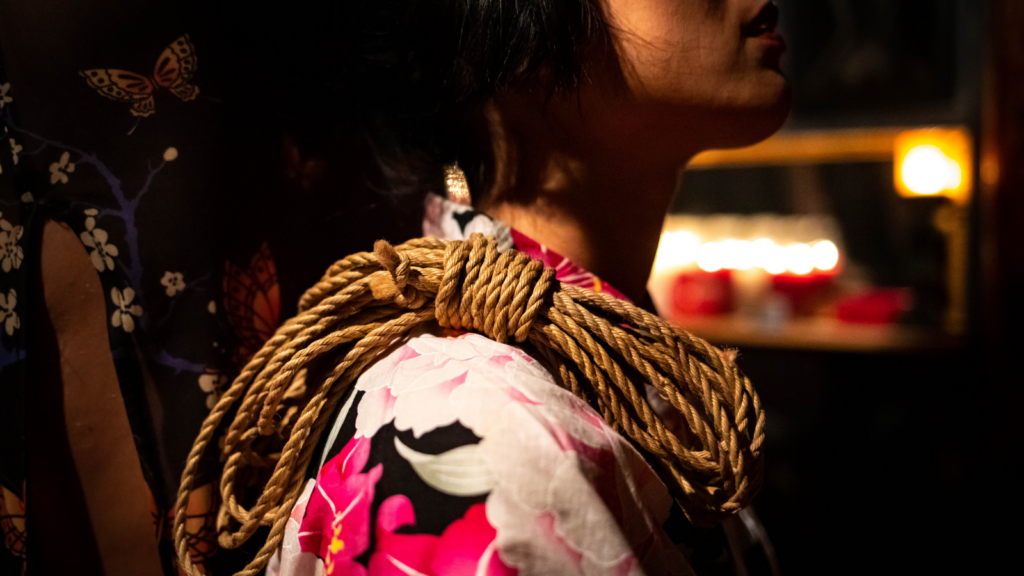
All BDSM scenes require negotiation, and there are specific concerns that should be addressed before engaging in a bondage scene. Partners should start with a general conversation about their skill levels, discuss the game plan for the scene (including goals and boundaries), and have a thorough discussion about relevant medical issues. While this guide isn’t meant to be exhaustive, it should be a good starting point for creating dialogue. Safety is a shared responsibility, and negotiation is key for both tops and bottoms.
General Skill Assessment
Start your scene negotiation with a general discussion about your mutual skills. Bottoms, it’s ok to interview your tops. You are putting your safety in their hands. Ask how long they have been playing and how they learned rope. If you are interested in a particular tie, ask how often the top has practiced that tie. Ask them how they plan to handle a scene going awry, and whether their cutting tool is reachable. Tops, ask similar questions of the bottom you are about to tie. Find out how long they’ve been playing and what they’ve liked and disliked. Ask how they plan to communicate pain or limits during the scene. Find out their safe word and whether they’ve ever used it. The point of negotiation is to empower communication. Encourage bottoms to speak up about pinching, tingling, or other issues. Both partners should agree that there is risk inherent in bondage and that they are consenting to those risks.
Scene Planning
Rope scenes are as varied as people. It’s important both partners are on the same wavelength about the intent and style of their scene. If the bottom is expecting the Romper Room and the top envisions herself as SheGod Destroyer of Worlds, the results could be pretty horrible (if comical). What energy do you need? Bondage can be stern, sensual, or silly. Talk about intensity too! On a level of 1-10, what is your goal? What sort of ties do you each enjoy the most, and what do you really hate? What are your hard limits? Make sure your expectations regarding aftercare match up too.
Everyone has boundaries, tops and bottoms alike, and it’s critical to talk them over as clearly as possible. I prefer to get additional clarity and consent for certain forms of play. These are specific things that in my years of practice are often off-limits for new bondage partners: crotch rope, hair rope, breast/genital bondage, blindfolds, or gags. As a top, I never use blindfolds or gags on a first play date, because they hinder communication. Tops, ask your bottoms how they feel about rope marks. If marks are an issue, I suggest using MFP rope instead of natural fiber rope. Suspensions are much more likely to leave marks than floor work, as a general rule. If you are playing in a spot where photos are allowed, you may want to discuss taking pictures to remember the scene. Obviously, never take photos of anyone without their full consent. At parties, it’s polite to check whether they are with a partner, and if that partner wishes to watch or has any additional boundaries.
What sort of touching is ok? While contact is expected, bottoms should notify tops what areas are off limits for touching. Ticklish spots such as feet and delicate areas, like the throat, are often triggers for people, in both good and bad ways. Most importantly, be clear about sexual activity! Never assume anything, and never pressure anyone. Plenty of hot kink can happen without any sexual contact. Even in the heat of the moment, don’t vary from your established boundaries. Just like a drunk person can’t legally or ethically consent, someone in the throes of subspace or topspace isn’t thinking 100% clearly either. If you didn’t negotiate it, don’t do it. It’s that simple. If you want to re-negotiate different boundaries before your next scene, that’s the time to change the rules of play. Besides, it’s hot to leave someone wanting more. It helps ensure there will BE a next time.
Health Questions
It’s important to run through a quick health and safety check before you start your scene. I always ask these questions when I play with a new partner, and I recheck with my regular partners to make sure nothing has changed since the last time I tied them up. If you’re using natural fiber rope, make sure no one in the scene has a hemp or jute allergy. I recommend riggers carry a backup set of synthetic rope just in case. Do either of you have asthma? Make sure there’s an inhaler nearby, and bear in mind that face-down suspensions are more difficult for breathing. If either partner is diabetic, make sure they have eaten recently and keep a sugar source nearby. If the bottom is diabetic, feet should be tied loosely due to poor circulation, using non-collapsing ties and extra wraps. Having a fainting top is no fun either, so bottoms, make sure your top has eaten too. Both partners should divulge any past seizures or fainting history. Tops with medical issues may want a friend on hand in case of emergency. Riggers, ask bottoms whether they have any injuries, or whether any positions are problematic. Finally, I like to ask bottoms whether they have any anxiety issues, history of panic attacks, or trauma triggers I should avoid.
Good negotiation skills help everyone have a safer and more fun bondage experience. Both partners have a shared responsibility to be as clear as possible regarding their proficiency, wishes, boundaries, and medical concerns. When in doubt, ask for clarification. If the answers don’t make you feel completely comfortable, it’s always okay to pass on the scene. Your health and safety deserve the best possible scenario, and thorough negotiations help minimize risk.
Lady Elizabeth has been involved in BDSM her entire adult life, both as a passion and a topic for academic research. She holds a PhD in linguistic anthropology from an Ivy League university, specializing in gender and sexuality. A professional dominant since 2000, she particularly enjoys teaching novices about the diverse world of BDSM.
